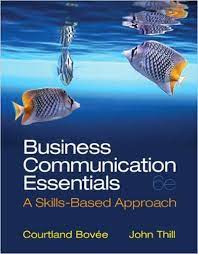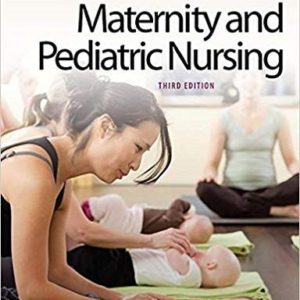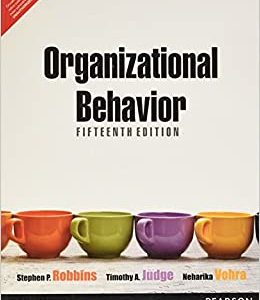Business Communication Essentials 6th Edition by Bovee Test Bank
$35
Description
Business Communication Essentials 6th Edition by Bovee Test Bank
Business Communication Essentials, 6e (Bovee/Thill)
Chapter 1 Understanding Business Communication in Today’s Workplace
1) Which of the following is true about the importance of effective communication to your career
and to the companies where you will work?
A) Communication is important for most jobs, except technical jobs such as engineering or
finance.
B) The higher you rise in your organization, the more time you spend using the technical skills of
your profession, and the less time you spend communicating.
C) Good communicators are generally more difficult to find than good accountants, good
engineers, or good attorneys.
D) Good communication has not been linked to financial advantages for companies.
E) Communication is important for most jobs, unless you are an entrepreneur.
Answer: C
Explanation: C) The world is full of good marketing strategists, good accountants, good
engineers, and good attorneys—but it is not full of good communicators. Acquiring good
communication skills will provide you with an opportunity to stand out from your competition in
the job market.
Classification: Conceptual
AACSB: Communication Abilities
LO: 1
Difficulty: Easy
Learning Outcome: Describe best practices in team and interpersonal communication
2) Which of the following is true about the importance of effective communication to your career
and to the companies where you will work?
A) Communication is important for most jobs, except technical jobs such as engineering or
finance.
B) The higher you rise in your organization, the less time you spend using the technical skills of
your profession, and the more time you spend communicating.
C) Good communicators are generally much easier to find than good accountants, good
engineers, or good attorneys.
D) Good communication has not been linked to financial advantages for companies.
E) Communication is important for most jobs, unless you are an entrepreneur.
Answer: B
Explanation: B) As you take on leadership and management roles, communication becomes
even more important. The higher you rise in an organization, the less time you will spend using
the technical skills of your particular profession and the more time you will spend
communicating. Top executives spend most of their time communicating, and businesspeople
who can’t communicate well don’t stand much chance of reaching the top.
Classification: Conceptual
AACSB: Communication Abilities
LO: 1
Difficulty: Easy
Learning Outcome: Describe best practices in team and interpersonal communication
1
3) Which of the following is true about the importance of effective communication to your career
and to the companies where you will work?
A) Communication is important for most jobs, except technical jobs such as engineering or
finance.
B) The higher you rise in your organization, the more time you spend using the technical skills of
your profession, and the less time you spend communicating.
C) Good communicators are generally much easier to find than good accountants, good
engineers, or good attorneys.
D) Companies that communicate well significantly outperform those that communicate poorly.
E) Communication is important for most jobs, unless you are an entrepreneur.
Answer: D
Explanation: D) Good communication has clear financial advantages. Companies that
communicate well significantly outperform those that communicate poorly.
Classification: Conceptual
AACSB: Communication Abilities
LO: 1
Difficulty: Easy
Learning Outcome: Describe best practices in team and interpersonal communication
4) Effective communication strengthens the connections between a company and all of its
________.
A) factions
B) cliques
C) stakeholders
D) captive audience
E) captive market
Answer: C
Explanation: C) A company’s stakeholders are those groups that are affected in some way by the
company’s actions: customers, employees, shareholders, suppliers, neighbors, the community, the
nation, and the world as a whole.
Classification: Conceptual
LO: 1
Difficulty: Easy
Learning Outcome: Discuss the challenges and importance of business communications
2
5) Effective business messages ________.
A) convey abstract ideas
B) provide practical information
C) are usually voluminous
D) do not attempt to influence the reader
E) are usually informal
Answer: B
Explanation: B) To make your communication efforts as effective as possible, provide practical
information. Give recipients useful information, whether it’s to help them perform a desired
action or understand a new company policy.
Classification: Conceptual
AACSB: Communication Abilities
LO: 1
Difficulty: Easy
Learning Outcome: Describe strategies for developing persuasive business messages
6) To be effective, business messages should ________.
A) use abstract words that lend themselves to interpretation
B) never contain opinions
C) present expansive and repetitive information
D) not make arguments or recommendations
E) give facts rather than vague impressions
Answer: E
Explanation: E) To make your communication efforts as effective as possible, give facts rather
than vague impressions. Use concrete language, specific detail, and information that is clear,
convincing, accurate, and ethical. Even when an opinion is called for, present compelling
evidence to support your conclusion.
Classification: Conceptual
AACSB: Communication Abilities
LO: 1
Difficulty: Easy
Learning Outcome: Describe strategies for developing persuasive business messages
7) To be effective, business messages should ________.
A) use abstract words that lend themselves to interpretation
B) adopt an informal tone
C) present information in a concise, efficient manner
D) not make arguments or recommendations
E) never contain opinions
Answer: C
Explanation: C) To make your communication efforts as effective as possible, present
information in a concise, efficient manner. Concise messages show respect for people’s time, and
they increase the chances of a positive response.
Classification: Conceptual
AACSB: Communication Abilities
LO: 1
Difficulty: Easy
3
8) To be effective, business messages should ________.
A) use abstract words that lend themselves to interpretation
B) adopt an informal tone
C) never contain opinions
D) not make arguments or recommendations
E) show your readers how they will benefit by responding to your message
Answer: E
Explanation: E) To make your communication efforts as effective as possible, you should offer
compelling, persuasive arguments and recommendations. Show your readers precisely how they
will benefit by responding the way you want them to respond to your message.
Classification: Conceptual
AACSB: Communication Abilities
LO: 1
Difficulty: Easy
Learning Outcome: Describe strategies for developing persuasive business messages
9) To be effective, business messages should ________.
A) generate a specific response from a specific audience
B) adopt an informal tone
C) use abstract words that lend themselves to interpretation
D) not make arguments or recommendations
E) never contain opinions
Answer: A
Explanation: A) To make your communication efforts as effective as possible, you should clarify
expectations and responsibilities. Craft messages to generate a specific response from a specific
audience. When appropriate, clearly state what you expect from audience members or what you
can do for them.
Classification: Conceptual
AACSB: Communication Abilities
LO: 1
Difficulty: Easy
Learning Outcome: Describe strategies for developing persuasive business messages
4
10) Which of the following is true about communicating in today’s business environment?
A) Following accepted standards of grammar, spelling and other aspects of high-quality business
writing are no longer relevant in today’s technology-driven business environment.
B) One should always communicate ethically, even when the choices are not crystal clear.
C) Constructing compelling narratives—telling stories—is obsolete in today’s fast-paced
business environment.
D) Adapting your messages and communication styles to specific audiences is unethical and,
often, illegal.
E) It is now an accepted fact that business communication skills are largely innate and cannot be
learnt.
Answer: B
Explanation: B) Communicating ethically, even when the choices are not crystal clear, is an
important communication task that one must be proficient at in today’s business environment.
Classification: Conceptual
AACSB: Communication Abilities
LO: 2
Difficulty: Moderate
Learning Outcome: Describe the opportunities and challenges of communicating in a diverse
world
11) Which of the following is true about communicating in today’s business environment?
A) It is important to recognize that it is not possible to communicate ethically when the choices
are not crystal clear.
B) Following accepted standards of grammar, spelling and other aspects of high-quality business
writing are no longer relevant in today’s technology-driven business environment.
C) Constructing compelling narratives—telling stories—is obsolete in today’s fast-paced
business environment.
D) Adapting your messages and communication styles to specific audiences is crucial to business
communication today.
E) It is now an accepted fact that business communication skills are largely innate and cannot be
learnt.
Answer: D
Explanation: D) Given the importance of communication in business, employers expect you to
be competent at a wide range of communication tasks, adapting your messages and
communication styles to specific audiences and situations.
Classification: Conceptual
AACSB: Communication Abilities
LO: 2
Difficulty: Moderate
Learning Outcome: Discuss the challenges and importance of business communications
5
12) Which of the following is the first step in the basic eight-step communication model?
A) The sender transmits the message through a channel.
B) The sender produces the message in a medium.
C) The sender has an idea.
D) The sender writes the message.
E) The sender organizes the message.
Answer: C
Explanation: C) The communication process starts with a sender having an idea and then
encoding the idea into a message that can be transferred to a receiver.
Classification: Conceptual
AACSB: Communication Abilities
LO: 3
Difficulty: Easy
Learning Outcome: Describe best practices in team and interpersonal communication
13) Which of the following is the last step in the basic eight-step communication model?
A) The sender transmits the message through a channel.
B) The audience receives the message.
C) The receiver decodes the message.
D) The receiver responds to the message
E) The receiver provides feedback.
Answer: E
Explanation: E) If a mechanism is available for them to do so, receivers can “close the loop” in
the communication process by giving the sender feedback that helps the sender evaluate the
effectiveness of the communication effort. Feedback can be verbal, nonverbal, or both.
Classification: Conceptual
AACSB: Communication Abilities
LO: 3
Difficulty: Easy
Learning Outcome: Describe best practices in team and interpersonal communication
14) In the basic communication model, when someone puts an idea into a message, he or she is
________.
A) encoding it
B) decoding it
C) broadcasting it
D) indexing it
E) cataloguing it
Answer: A
Explanation: A) When someone puts an idea into a message, he or she is encoding it, or
expressing it in words or images. This forms the second step in the basic eight-step
communication model.
Classification: Conceptual
LO: 3
Difficulty: Easy
Learning Outcome: Discuss the challenges and importance of business communications
6
15) After a message is received, the receiver needs to extract the idea from the message, a step
known as ________.
A) encoding
B) decoding
C) abstracting
D) indexing
E) cataloguing
Answer: B
Explanation: B) After a message is received, the receiver needs to extract the idea from the
message, a step known as decoding.
Classification: Conceptual
LO: 3
Difficulty: Easy
Learning Outcome: Discuss the challenges and importance of business communications
16) Which of the following examples correctly illustrates the difference between what constitutes
a communication medium and a communication channel?
A) A telephone is a medium, while a voice message is a channel.
B) A cell phone is a medium, while a text message is a channel.
C) A shipping company is a medium, while a printed report is a channel.
D) A podcast is a medium, while an intranet is a channel.
E) The Internet is a medium, while a Twitter tweet is a channel.
Answer: D
Explanation: D) The medium is the form a message takes (such as a podcast) and the channel is
the system used to deliver the message (such as an intranet).
Classification: Application
AACSB: Communication Abilities; Analytic Skills; Ethical Understanding and Reasoning
Abilities
LO: 3
Difficulty: Moderate
Learning Outcome: Discuss the challenges and importance of business communications
7
17) The traditional nature of much business communication was primarily defined by a
publishing or broadcasting mindset. Which of the following scenarios best reflects this mindset?
A) A company airs advertisements during the Super Bowl to raise its visibility.
B) A company publishes a blog to keep customers informed of the company’s activities.
C) A company CEO uses Twitter to interact directly with individual employees.
D) A company opens a Facebook account to connect with a younger audience.
E) A company holds a townhall-style meeting to respond to employee concerns.
Answer: A
Explanation: A) The traditional nature of much business communication was primarily defined
by a publishing or broadcasting mindset. Externally, a company issued carefully scripted
messages to a mass audience that often had few options for responding to those messages or
initiating messages of their own, such as in this scenario. Internally, communication tended to
follow the same “we talk, you listen” model, with upper managers issuing directives to lowerlevel
supervisors and employees.
Classification: Application
AACSB: Communication Abilities; Analytic Skills; Ethical Understanding and Reasoning
Abilities
LO: 3
Difficulty: Difficult
Learning Outcome: Discuss the challenges and importance of business communications
18) The ________ is interactive, conversational, and usually open to all who wish to participate;
audience members are not passive recipients of messages but active participants in a
conversation.
A) publishing mindset
B) basic eight-step communication model
C) social communication model
D) broadcasting mindset
E) Business Communication 1.0
Answer: C
Explanation: C) In contrast to the publishing mindset, the new social communication model is
interactive, conversational, and usually open to all who wish to participate. Audience members
are no longer passive recipients of messages but active participants in a conversation.
Classification: Conceptual
AACSB: Communication Abilities
LO: 3
Difficulty: Easy
Learning Outcome: Discuss the challenges and importance of business communications
8
19) Which of the following is a tendency of Business Communication 1.0?
A) reactive
B) information hoarding
C) permission
D) information sharing
E) high message frequency
Answer: B
Explanation: B) The traditional nature of much business communication was primarily defined
by a publishing or broadcasting mindset—a “we talk, you listen” model of communication,
where information was hoarded, not shared.
Classification: Conceptual
AACSB: Communication Abilities
LO: 3
Difficulty: Easy
Learning Outcome: Discuss the challenges and importance of business communications
20) The most important element of audience-centered communication is ________.
A) etiquette
B) dialog
C) permission
D) discussion
E) high message frequency
Answer: A
Explanation: A) An important element of audience-centered communication is etiquette, the
expected norms of behavior in a particular situation.
Classification: Conceptual
AACSB: Communication Abilities
LO: 2
Difficulty: Easy
Learning Outcome: Discuss the challenges and importance of business communications
21) Which of the following is a tendency of Business Communication 2.0?
A) resistive
B) information hoarding
C) planned
D) unidirectional
E) high message frequency
Answer: E
Explanation: E) One of the tendencies of Business Communication 2.0 is it is conversational in
nature.
Classification: Conceptual
AACSB: Communication Abilities
LO: 3
Difficulty: Easy
Learning Outcome: Discuss the challenges and importance of business communications
9
22) Business Communication 2.0 tends to be ________.
A) resistive
B) isolated
C) dynamic
D) structured
E) unidirectional
Answer: C
Explanation: C) Business Communication 2.0 tends to be dynamic.
Classification: Conceptual
AACSB: Communication Abilities
LO: 3
Difficulty: Easy
Learning Outcome: Discuss the challenges and importance of business communications
23) Business Communication 1.0 tends to be ________.
A) reactive
B) conversational
C) amorphous
D) isolated
E) multidirectional
Answer: D
Explanation: D) Business Communication 1.0 tends to be isolated.
Classification: Conceptual
AACSB: Communication Abilities
LO: 3
Difficulty: Easy
Learning Outcome: Discuss the challenges and importance of business communications
24) Which of the following is a tendency of Business Communication 2.0?
A) unidirectional
B) egalitarian
C) resistive
D) structured
E) information hoarding
Answer: B
Explanation: B) The social communication model is interactive, conversational, and usually
open to all who wish to participate.
Classification: Conceptual
AACSB: Communication Abilities
LO: 3
Difficulty: Easy
Learning Outcome: Discuss the challenges and importance of business communications
10
25) Which of the following is a tendency of Business Communication 2.0?
A) lecture
B) one to many
C) influence
D) control
E) static
Answer: C
Explanation: C) The social communication model is interactive, conversational, and usually
open to all who wish to participate. Companies aim to influence, not control, the audience in this
model.
Classification: Conceptual
AACSB: Communication Abilities
LO: 3
Difficulty: Easy
Learning Outcome: Discuss the challenges and importance of business communications
26) Which of the following is a tendency of Business Communication 2.0?
A) permission
B) hierarchical
C) one to many
D) control
E) few channels
Answer: A
Explanation: A) Permission is one of the tendencies of Business Communication 2.0.
Classification: Conceptual
AACSB: Communication Abilities
LO: 3
Difficulty: Easy
Learning Outcome: Discuss the challenges and importance of business communications
27) Business Communication 2.0 tends to be ________.
A) structured
B) hierarchical
C) unidirectional
D) reactive
E) intrusive
Answer: D
Explanation: D) Business Communication 2.0 tends to be reactive.
Classification: Conceptual
AACSB: Communication Abilities
LO: 3
Difficulty: Easy
Learning Outcome: Discuss the challenges and importance of business communications
11
28) Business Communication 2.0 tends to be ________.
A) amorphous
B) hierarchical
C) unidirectional
D) structured
E) intrusive
Answer: A
Explanation: A) Business Communication 2.0 tends to be amorphous.
Classification: Conceptual
AACSB: Communication Abilities
LO: 3
Difficulty: Easy
Learning Outcome: Discuss the challenges and importance of business communications
29) Which of the following is a disadvantage of the social communication model?
A) It is hierarchical.
B) The number of channels is limited in this model.
C) The frequency of messages on this model is relatively low.
D) It blurs the line between personal and professional lives.
E) It is unidirectional.
Answer: D
Explanation: D) Potential problems of the social communication model include information
overload, fragmented attention, information security risks, distractions that hurt productivity, and
the blurring of the line between personal and professional lives, which can make it difficult for
people to disconnect from work.
Classification: Conceptual
AACSB: Communication Abilities
LO: 3
Difficulty: Easy
Learning Outcome: Discuss the challenges and importance of business communications
30) Which of the following is a disadvantage of the social communication model?
A) It is hierarchical.
B) It is static.
C) It can lead to information overload.
D) The frequency of messages is relatively low.
E) It is unidirectional.
Answer: C
Explanation: C) Potential problems of the social communication model include information
overload, fragmented attention, information security risks, distractions that hurt productivity, and
the blurring of the line between personal and professional lives, which can make it difficult for
people to disconnect from work.
Classification: Conceptual
AACSB: Communication Abilities
LO: 3
Difficulty: Easy
Learning Outcome: Discuss the challenges and importance of business communications
You must be logged in to post a review.





Reviews
There are no reviews yet.